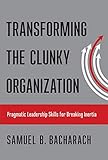Transforming the Clunky Organization : Pragmatic Leadership Skills for Breaking Inertia / Samuel B. Bacharach.
Material type: TextSeries: The Pragmatic Leadership SeriesPublisher: Ithaca, NY : Cornell University Press, [2018]Copyright date: ©2018Description: 1 online resource (210 p.) : 11 b&w halftonesContent type:
TextSeries: The Pragmatic Leadership SeriesPublisher: Ithaca, NY : Cornell University Press, [2018]Copyright date: ©2018Description: 1 online resource (210 p.) : 11 b&w halftonesContent type: - 9781501710049
- 658.4/092 23
- HD58.8 .B334 2018
- online - DeGruyter
| Item type | Current library | Call number | URL | Status | Notes | Barcode | |
|---|---|---|---|---|---|---|---|
 eBook
eBook
|
Biblioteca "Angelicum" Pont. Univ. S.Tommaso d'Aquino Nuvola online | online - DeGruyter (Browse shelf(Opens below)) | Online access | Not for loan (Accesso limitato) | Accesso per gli utenti autorizzati / Access for authorized users | (dgr)9781501710049 |
Browsing Biblioteca "Angelicum" Pont. Univ. S.Tommaso d'Aquino shelves, Shelving location: Nuvola online Close shelf browser (Hides shelf browser)

|

|

|

|

|

|

|
||
| online - DeGruyter Oneida Utopia : A Community Searching for Human Happiness and Prosperity / | online - DeGruyter Writing the Wrongs : Eva Valesh and the Rise of Labor Journalism / | online - DeGruyter The Agenda Mover : When Your Good Idea Is Not Enough / | online - DeGruyter Transforming the Clunky Organization : Pragmatic Leadership Skills for Breaking Inertia / | online - DeGruyter Populating the Novel : Literary Form and the Politics of Surplus Life / | online - DeGruyter From Miracle to Mirage : The Making and Unmaking of the Korean Middle Class, 1960-2015 / | online - DeGruyter History Is a Contemporary Literature : Manifesto for the Social Sciences / |
Frontmatter -- Contents -- PREFACE: THE PRAGMATIC LEADER AND ORGANIZATIONAL INERTIA -- ACKNOWLEDGMENTS -- 1. THE CHALLENGE OF INERTIA -- Sluggish Organizations: Clunky and Myopic -- Reaching Potential: Leading for Discovery and Delivery -- 2. LEADING FOR ROBUST DISCOVERY -- Explore the Context -- Facilitate Ideation -- 3. LEADING FOR FOCUSED DELIVERY -- Campaign for Support -- Sustain Momentum -- CONCLUSION: PRAGMATIC LEADERSHIP AND THE COUCH-POTATO ORGANIZATION -- NOTES -- INDEX
restricted access online access with authorization star
http://purl.org/coar/access_right/c_16ec
Organizations, like people, get stuck! They get ensnared in routines and processes, and they fall back into old habits. This is the dangerous period of inertia, the period that precedes failure, when organizations show signs of sluggishness.In Transforming the Clunky Organization Samuel B. Bacharach specifies why organizations fall into patterns of inertia and details the critical pragmatic leadership skills leaders need to regain organizational momentum. From Alfred Sloan, to Lee Iacocca, to Lou Gerstner, to Indra Nooyi, to Steve Jobs, to Jeff Bezos, Bacharach argues that their pragmatic leadership skills assured that their organization did not get trapped by the doldrums of inertia. He employs case illustrations to identify clunky tendencies and inertia within organizations across a wide range of business sectors including technology, finance, banking, home entertainment, and retail. Illustrations are drawn from organizations such as Amazon, Apple, Borders, Merrill Lynch, Nintendo, Starbucks, and Unilever, among many others.Bacharach argues that in order to achieve their potential, organizations need to be perpetually involved in two activities. The first is discovery—organizational leaders need to continuously explore new opportunities and transfer new insights into new products, processes, and directions. The second is delivery—organizational leaders need to be able to mobilize support for ideas, sustain and drive these ideas forward, and achieve results. Successful discovery and delivery allows organizations to truly thrive and continuously meet their potential.Expanding on The Agenda Mover, the first book in the BLG Pragmatic Leadership Series, this book offers a roadmap for individual leaders at all levels to create the agility and synergy needed for the continuous organized flow of information and the movement of ideas. Clunky organizations need leaders that are explorers and innovators in the discovery phase and mobilizers and sustainers to deliver solutions. Transforming the Clunky Organization provides the keys for necessary behaviors that allow leaders to successfully break inertia and foster agility.This book will appeal to leaders at all levels within organizations, change-management consultants, and business-school professors.
Mode of access: Internet via World Wide Web.
In English.
Description based on online resource; title from PDF title page (publisher's Web site, viewed 26. Apr 2024)


